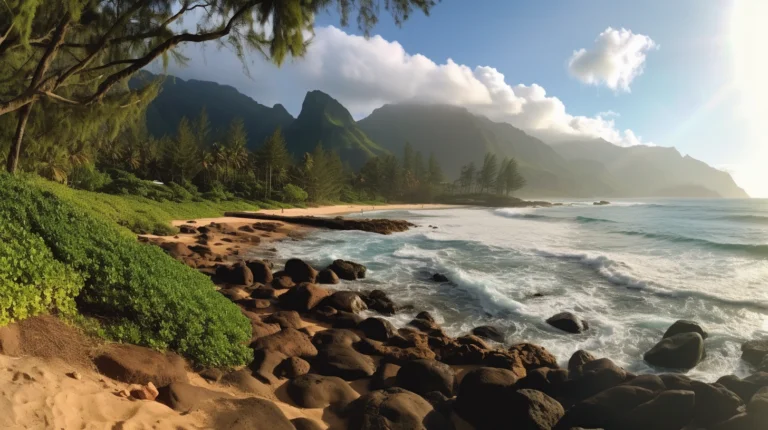Discover the Melodic Heartbeat of Kauai 🌺 Hawaiian Music and Culture
Are you planning a trip to Kauai and wondering what kind of music you might hear during your stay? Look no further than Hawaiian melodies!
Hawaiian music is a unique blend of Polynesian, European, and American influences, and it has a rich history that dates back centuries. From traditional chants and hula songs to modern pop hits, there is something for everyone to enjoy.
In this article, we will introduce you to the music of Kauai and the wider Hawaiian culture. We will explore the different instruments used in Hawaiian music, the various styles of Hawaiian music, and some of the most famous Hawaiian musicians of all time.
We will also give you tips on how to experience Hawaiian music during your visit to Kauai and discuss the important role that music plays in Hawaiian culture. So sit back, relax, and prepare to be transported to a world of beautiful melodies and rhythms.
Key Takeaways
- Hawaiian music is a unique blend of Polynesian, European, and American influences with a rich history dating back centuries.
- Traditional instruments such as ukulele, steel guitar, and bass provide the foundation of melody and groove, with improvisation techniques important for bassists.
- Hula music and slack-key guitar are two distinct styles with rhythmic chanting and finger-picking techniques respectively, both characterized by a relaxed and soothing vibe.
- Music education and preservation are crucial for maintaining cultural heritage, passing it on to future generations, and inspiring a sense of pride and belonging in Hawaiian traditions and customs.
Introduction to Hawaiian Music
You’re about to learn all about Hawaiian music and its unique melodies, so get ready to be transported to the beautiful island of Kauai! Hawaiian music has a fascinating history and evolution that spans several centuries. It has been influenced by various cultures, including Polynesia, Asia, and Europe, and has evolved into a distinct style that is recognizable around the world.
The cultural significance of Hawaiian music cannot be overstated. It is a vital part of Hawaii’s heritage and is deeply intertwined with the traditions and customs of the Hawaiian people. From ancient chants and hula dances to modern pop songs, Hawaiian music has always had the power to connect people to their roots and inspire a sense of pride and belonging.
Now, let’s dive deeper into the world of Hawaiian music and explore the traditional Hawaiian instruments that make it so unique.
Traditional Hawaiian Instruments
Now let’s delve into the traditional Hawaiian instruments, which include the ukulele, steel guitar, and bass. These instruments have played a significant role in the development of Hawaiian music and continue to be widely used today.
The ukulele, with its sweet and distinctive sound, has become a symbol of Hawaiian culture and is often associated with hula dancing and beachside jams. The steel guitar, on the other hand, is known for its smooth gliding tones that evoke the feeling of ocean waves, while the bass provides a steady foundation to the rhythm and melody of the music.
Ukulele
The ukulele’s sweet, lilting sound will transport you to the shores of Kauai and fill your heart with joy. This small, four-stringed instrument has become synonymous with Hawaiian music and culture, but its origins can be traced back to Portugal.
The ukulele was introduced to Hawaii in the late 19th century and quickly became popular among the locals. Over time, the ukulele has become an essential part of Hawaiian music and is often used to accompany songs and hula dances.
If you’re new to playing the ukulele, there are a few techniques you should know. First, it’s important to hold the instrument correctly. The ukulele should rest comfortably on your lap or against your chest, with the neck pointing upwards.
To play a note, press down on the string with your finger at a specific fret and strum the string with your other hand. You can create different sounds and rhythms by strumming in different patterns or by plucking the strings with your fingers. With just a little practice, you’ll be able to play some of the most beautiful Hawaiian melodies on your ukulele.
Now that you’ve learned a bit about the ukulele’s history and playing techniques, let’s move on to another important instrument in Hawaiian music: the steel guitar.
Steel Guitar
Get ready to feel the soulful twang of the Hawaiian steel guitar, transporting you to the heart of Hawaiian culture. This unique instrument has a rich history and evolution, dating back to the late 19th century when Portuguese immigrants brought their own version of the guitar to the Hawaiian islands. The instrument quickly caught on and underwent several transformations, leading to the creation of the steel guitar.
The Hawaiian steel guitar is played by sliding a metal bar or tone bar over the strings, creating a smooth gliding sound. The instrument’s popularity grew in the early 20th century, and it became a staple in Hawaiian music, influencing the development of genres such as country and western. Today, the steel guitar remains an essential part of Hawaiian music, with many artists continuing to innovate and push the boundaries of the instrument. Check out the table below for a brief overview of the history and evolution of the Hawaiian steel guitar.
| Time Period | Evolution of the Hawaiian Steel Guitar |
|---|---|
| Late 19th century | Portuguese immigrants arrive with their own version of the guitar |
| Early 20th century | Hawaiian musicians adapt the guitar, leading to the creation of the steel guitar |
| Mid 20th century | The steel guitar becomes a staple in Hawaiian music, influencing the development of other genres |
| Late 20th century | Artists continue to innovate and push the boundaries of the instrument |
| Present day | The steel guitar remains an essential part of Hawaiian music |
As we move onto the next section about bass, keep in mind the important role the steel guitar plays in shaping the sound of Hawaiian music.
Bass
Let’s groove to the thumping rhythm of the bass, a crucial component in the sound of many genres of music.
In Hawaiian music, the bass plays an important role in providing the foundation of the melody and creating the overall groove of the song. Music theory is essential in understanding the role of the bass in any genre of music, and in Hawaiian music, the bass is no exception. Understanding music theory can help a bassist create a strong foundation for the melody and rhythm of the song, allowing them to improvise and create their own unique sound.
Improvisation techniques are also important for any bassist playing Hawaiian music. With improvisation, a bassist can add their own style and flavor to the song, making it unique and memorable. In Hawaiian music, the bassist often incorporates techniques such as slides and bends to create a more fluid and melodic sound. Additionally, the bassist may use syncopation to add a bit of funk and groove to the song. All of these techniques come together to create a unique sound that is essential to Hawaiian music.
As we move on to discuss the different styles of Hawaiian music, it’s important to understand the role of the bass in each style. Whether it’s the upbeat rhythms of hula or the soulful melodies of slack key guitar, the bass provides the foundation for the music to flourish.
Styles of Hawaiian Music
Now let’s delve into the different styles of Hawaiian music.
First up is Hula Music, which is characterized by rhythmic chanting and dancing that often tells a story.
Next, we have Slack-Key Guitar, a style that originated in Hawaii and features finger-picking techniques that create a unique sound.
Lastly, there is Contemporary Hawaiian Music, which blends traditional Hawaiian elements with modern instruments and styles to create a more contemporary sound.
Each style offers a different perspective on the rich musical history of Hawaii and is worth exploring in more detail.
Hula Music
Hula music, with its rhythmic beats and graceful melodies, has been an integral part of Hawaiian culture for centuries. The music is meant to accompany the hula dance, which is a storytelling dance that conveys the history and culture of the Hawaiian people.
The hula dance is not just a form of entertainment, but it’s also a way to preserve the traditions and values of the Hawaiian people. The cultural significance of hula music is immense. It was traditionally performed at important events such as weddings, births, and funerals.
The music and dance were also used to honor the gods and goddesses of the Hawaiian religion. Today, hula music is still an important part of Hawaiian culture and is performed at festivals, events, and in daily life. The haunting melodies and rhythmic beats of hula music continue to captivate audiences around the world.
As we move on to the next section about slack-key guitar, it’s important to note that this style of music also has deep roots in Hawaiian culture.
Slack-Key Guitar
You’ll be amazed by the soulful sound and intricate fingerpicking of slack-key guitar. It’s a style of music deeply rooted in Hawaiian culture and known for its relaxed and soothing vibe.
Hawaiian fingerpicking is a fundamental aspect of slack-key guitar. The fingers are used to pluck the strings in a melodic and rhythmic manner. The open tunings used in slack-key guitar create a unique sound that is distinct from other guitar styles. In fact, some of the open tunings used in slack-key guitar are specific to the Hawaiian Islands and can’t be found elsewhere.
Slack-key guitar was originally played by Hawaiian cowboys, who would tune their guitars differently to create a relaxed and soulful sound. Today, slack-key guitar is played by many musicians in Hawaii and around the world. It has become an iconic symbol of Hawaiian music.
The intricate fingerpicking and open tunings used in slack-key guitar create a distinct sound that captures the essence of the Hawaiian Islands. As you delve deeper into the music of Kauai, you’ll discover that slack-key guitar is just one of the many unique sounds that make up the rich tapestry of Hawaiian music.
Contemporary Hawaiian Music
If you’re looking for a fresh and upbeat take on traditional Hawaiian sounds, contemporary Hawaiian music is the perfect choice.
Contemporary Hawaiian music is a fusion of traditional Hawaiian melodies and modern musical genres, such as rock, reggae, and hip-hop. This genre emerged in the 1990s and has since gained popularity around the world.
Contemporary Hawaiian music has been shaped by a number of talented artists who have taken the traditional Hawaiian sounds to new heights. Some of the most famous contemporary Hawaiian musicians include Israel Kamakawiwo’ole, a singer-songwriter who blended traditional Hawaiian music with reggae and folk; Keali’i Reichel, a singer, songwriter, and hula dancer who has won multiple Grammy nominations; and Jack Johnson, a singer-songwriter who incorporates elements of folk, rock, and acoustic music into his work.
These artists have taken Hawaiian music to new heights, blending traditional melodies with contemporary sounds to create a truly unique and vibrant musical genre.
Famous Hawaiian Musicians
You may already know some famous Hawaiian musicians, such as Israel Kamakawiwo’ole or Don Ho. However, there are many other talented musicians from the islands who have made a significant impact on Hawaiian music. For instance, Keali’i Reichel, a native of Maui, is a renowned composer and performer who has won multiple Na Hoku Hanohano awards, Hawaii’s version of the Grammy Awards. His music is a blend of traditional Hawaiian chants and contemporary sounds, and his powerful voice has captivated audiences around the world.
Another famous Hawaiian musician is Jake Shimabukuro, a ukulele virtuoso who has collaborated with artists such as Yo-Yo Ma and Bette Midler. Shimabukuro’s unique style of playing has redefined the perception of the ukulele, elevating it from a novelty instrument to a serious musical tool. His performances are a testament to the beauty and versatility of Hawaiian music, and his influence has inspired a new generation of musicians to explore their cultural roots.
If you want to learn more about the diversity of Hawaiian music, there are many opportunities to experience it on Kauai. From traditional hula performances to contemporary concerts, the island offers a range of events that showcase the richness of Hawaiian culture. So, get ready to immerse yourself in the melodies and rhythms of the islands, and discover why Hawaiian music has captured the hearts of people around the world.
How to Experience Hawaiian Music on Kauai
Immerse yourself in the vibrant sounds of the islands by attending traditional hula performances and contemporary concerts on the beautiful island of Kauai. There are several music venues on the island where you can listen to local musicians playing their instruments and singing traditional Hawaiian melodies.
Here are some of the ways you can experience Hawaiian music on Kauai:
- Attend a traditional hula performance: Hula is a form of dance that tells stories through movement and music. Many hula performances on Kauai feature live music played on traditional instruments such as the ukulele, guitar, and steel guitar.
- Check out the local music scene: Kauai is home to many talented musicians who play a variety of genres including reggae, rock, and traditional Hawaiian music. Check out local bars and restaurants to discover new artists and enjoy live music.
- Attend a music festival: Kauai hosts a number of music festivals throughout the year, including the Kauai Music Festival and the Kauai Folk Festival. These events showcase a range of musical genres and provide an opportunity to experience the diversity of Hawaiian music.
Music is an integral part of Hawaiian culture and has been passed down through generations as a means of storytelling and celebration. Understanding the role of music in Hawaiian culture is crucial to fully appreciate the beauty and richness of the melodies you’ll hear on Kauai.
The Role of Music in Hawaiian Culture
As you stroll along the beaches of Hawaii, you may hear the soft strumming of a ukulele or the melodic chanting of ancient Hawaiian lyrics. Music is deeply woven into the fabric of Hawaiian culture and has played an integral role in the history and storytelling of the islands. From hula dances to chants and songs, music has been a means of transmitting knowledge, values, and traditions from generation to generation.
The importance of music education cannot be overstated in Hawaiian culture. From a young age, children are taught the art of hula and the traditions associated with it. They are also taught to play traditional Hawaiian instruments such as the ukulele, the slack key guitar, and the steel guitar. Music education not only preserves the cultural heritage of the islands but also instills a sense of pride and identity in the younger generations. Music is not just a form of entertainment in Hawaii but a way of life that connects people to their roots and traditions.
Preserving Hawaiian music is crucial to ensure that future generations can continue to learn and appreciate the rich cultural heritage of the islands. As you delve deeper into the music of Kauai, you will learn about the various efforts that have been made to preserve the traditional Hawaiian music and the role that music plays in keeping the Hawaiian culture alive.
Preserving Hawaiian Music
Preserving the traditional music of Hawaii is critical to maintaining the cultural heritage of the islands and passing it on to future generations. Hawaiian music is a unique blend of different cultures, including Polynesian, Asian, and Western influences. It is an important symbol of the islands’ identity and is deeply intertwined with the language, dance, and history of Hawaii.
Here are three reasons why preserving Hawaiian music is crucial:
- Cultural Heritage: Hawaiian music is an integral part of the cultural heritage of the islands. It reflects the values, beliefs, and traditions of the Hawaiian people and is a source of pride and identity for them. Preserving this music is essential to keep the culture alive and thriving.
Historical Significance: Hawaiian music has a rich history that dates back centuries. It has played an important role in the social, political, and economic life of the islands. Preserving this music helps us understand the past, and how it influences the present.
- Educational Value: Hawaiian music is an excellent tool for educating people about the culture and history of Hawaii. It provides a window into the islands’ unique identity and promotes cross-cultural understanding. Preserving this music ensures that future generations will have access to this valuable educational resource.
In conclusion, preserving Hawaiian music is essential to maintain the cultural heritage of the islands and pass it on to future generations. By recognizing the importance of this music and taking steps to preserve it, we can ensure that it continues to play a vital role in the social, cultural, and educational life of Hawaii.
Conclusion and Call to Action
Let’s take a journey through the lush green landscapes of Hawaii and discover the soulful sounds that have been echoing through the valleys and shores for centuries. We have explored the importance of preserving Hawaiian music in the previous subtopic, and it is crucial that we continue to support local Hawaiian musicians who are keeping the traditional melodies alive.
One way to support these artists is by attending their concerts and purchasing their albums. By doing so, we not only appreciate their talents but also contribute to the preservation of Hawaiian culture. Additionally, we can spread the word about these musicians and their music through social media platforms, promoting their work to a wider audience.







